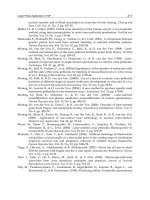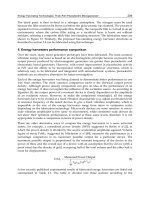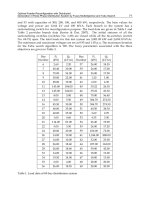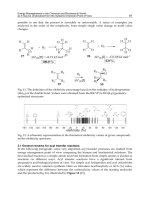Energy Technology and Management Part 12 ppt
Bạn đang xem bản rút gọn của tài liệu. Xem và tải ngay bản đầy đủ của tài liệu tại đây (1.71 MB, 18 trang )
Methodology Development for a Comprehensive
and Cost-Effective Energy Management in Public Administrations
211
While the model created for the climatic area E is reliable, the one for the climatic area F
needs more accurate information because the predicted consumptions are always lower
than the one predicted by the other model and it is unacceptable because the Area F has a
colder climate. Fig. 4 reports the predicted consumptions for both the climatic areas in
ascending order: it’s clear that the class F’s consumptions are always lower. This problem is
due to the availability of a little number of data belonging to the climatic area F. Our
approach is however addressed to the creation of different models for every climatic area,
obviously taking into proper account a correct number of data.
Fig. 4. Comparison between the model consumption of the climatic area E and F
Then, the ratio between the real consumptions and the predicted ones is calculated. In this
way the energy performance of every municipality can be classified through the Efficiency
Ratio (ER) defined as follows:
ER=
ln(E
c,r
)
ln(E
c,p
)
(12)
where E
c,r
and E
c,p
represent the real and the predicted energy consumption, respectively.
The greater is ER, the worst is the PA energy management.
The successive step is to fit the results of the efficiency ratio data in a cumulative
percentage profile: the result for the total annual electrical consumption is reported in
Figure 5. These curves allow determining the performance indexes or attributing the PA
to a specific class of consumption. We could decide to assign a score to every municipality
corresponding to the complement to 100 of the percentage value of the considered
municipality, depending on the ER value. In this study four classes of consumption,
identified by efficiency ratio thresholds corresponding to 0.25, 0.50 and 0.75 have been
defined. Two positive results can be immediately achieved: on the one hand the
attribution to a particular class of efficiency (i.e. labeled by a color) is an immediate result
for the municipality and on the other hand this is a powerful approach to compare
different municipalities and to assess future targets.
Energy Technology and Management
212
Fig. 5. Cumulative percentage curve for the efficiency ratio of the electrical consumptions
In Table 5 the ER boundary values of the four classes for both electrical and thermal
consumption is reported. The final result is a complete and detailed overview about the
energy consumption of the administration.
Efficiency ratios-Electrical consumption Lower limit Upper limit
Good performance
0.6967 0.9778
Amendable
0.9778 1.0023
Very amendable
1.0023 1.0229
Critical consumption
1.0229 1.1811
Efficiency ratios-Thermal consumption Lower limit Upper limit
Good performance
0.8445 0.9835
Amendable
0.9835 0.9998
Very amendable
0.9998 1.0153
Critical consumption
1.0153 1.1257
Table 5. Class of consumption for the municipality
Considering the other two levels, two different approaches have to be distinguished: a top-
down or a bottom-up approach. A top-down approach is necessary when the PA has only
aggregate data: it’s an easy implementable method but it has a great inertia in modifying the
benchmark results as a consequence of changes in the way of consuming. On the contrary a
bottom-up approach requires detailed information about the user characteristics, which are
often not available. Here the present method has been employed to develop indexes for the
top-down approach and different benchmarks available in literature for the bottom-up
approach are revised.
Methodology Development for a Comprehensive
and Cost-Effective Energy Management in Public Administrations
213
Fig. 6. Comparison between bottom-up and top-down approach
Using the same benchmark procedures for the whole administration, the regression
equations for forecasting the electrical and thermal consumptions in each sector of the
municipality can be calculated as indicated in paragraph 2. The data used in these cases are
the total annual electrical and thermal consumptions for each sector: the mean consumption
value is calculated over three years. The considered energy drivers are the sum of heating
gross surfaces of the users and the annual Heating Degree Days (general data which can be
applied in every organization).
As in the previous case the regression equations and the four classes of consumption are
determined.
Then, to validate the approach, a comparison between the results obtained by the efficiency
ratios (which classify the performance of the entire sector) and what emerges from the
evaluation of the single user indexes is performed. The result (in terms of class of energy
performance of the whole sector) of the efficiency ratios should coincide with the mean
result of the users indicators.
As indexes for the so-defined bottom-up approach for the single users we decide to revise
and adapt to our specific aim some indicators found in literature.
In general these indexes use detailed information to normalize the energy consumption with
respect to the climate conditions, the level and the type of usage, the structural
characteristics of the buildings or of the plants.
We report an interesting example of this type of comparison, illustrating the case of
“schools” but the same reasoning has been made for the other types of users.
The indexes for the schools, defined by the FIRE (Italian Federation for the Rational use of
Energy), are the IEN
E
and the IEN
R
(respectively Energetic Normalized Index for electricity
and thermal consumption).
These indexes are calculated for every school formulas as it follows:
IEN
R
=
C
Ther
·1000·F
h
·F
e
DD·V
IEN
E
=
C
El
·F
h
S
(13)
where C
Ther
is the annual heating consumption (kWh
therm
), C
El
is the annual electrical
consumption (kWh
el
), F
h
is a corrective factor concerning the hours of work, F
e
is a
Energy Technology and Management
214
corrective factor concerning the characteristics of the building (form factor S/V), DD are the
annual Heating Degree days, V the heating gross volume (m
3
), S the heating gross surface
(m
2
). The FIRE provides three classes of consumption regarding these indexes.
For the validation process the IEN
E
and the IEN
R
for a group of 48 schools homogeneously
distributed have been calculated and a class of efficiency for every school has been assigned.
This result has to coincide with one from the efficiency ratio (that is an efficiency but
averaged on the total of schools). In Table 6 the results are reported.
As it’s clear in the Table 6 the values concerning the thermal consumption show a great
correspondence between the two different approaches, instead of the electrical indexes
which give very different results in term of assessment of the performance. For
understanding this problem we observe the distribution of our sample of data according to
the IEN
E
and the IEN
R
and we note that our sample is concentrated in an inefficient
evaluation in term of IEN
E
.
Indice
IEN
R
47.92% 29.17% 22.92%
IEN
E
12.50% 22.92% 64.58%
Table 6. Distribution in the IEN
E
and IEN
R
classes
To realize a correct comparison we have to adapt our sample of data and re-define the limit
values of the IEN
E
’s classes: the IEN
E
is in fact the result of a study of simulation of the
energy performance of the schools instead our efficiency ratio gives a correct comparison
between the performance of a particular set of data. The scaled limit values are obtained
centering our dataset on the IEN
E
values.
Finally the pie graphs in Figure 7 show the final repartition of the consumption (respectively
thermal and electrical) of 7 schools existing in an example municipality; each school is
represented in the pie graphs with the color correspondent of the efficiency class defined by
the user’s indicator. It’s clear that the class with the major incidence in the total consumption
is correspondent of the class defined by the efficiency ratio
The same considerations have been developed on the other users typologies, creating
indexes allowing the sector’s classification and analyzing the most powerful benchmark in
literature for the classification of the single users. The results are reported in Table 7. A
different approach has been used only for the public lighting where the distinction between
sector and user indexes doesn’t make practical sense. In this case the most powerful
benchmarks come from an Italian research, making a technical and economic evaluation of
the lighting system of the municipality.
4. The case study
This method has been applied to the case study of two small towns close to Rome in the
region of Lazio, in Italy, called in this paragraph as municipalities A and B. These towns
don’t present any control in the energy management and for this reason the phase of the real
time monitoring net couldn’t be insert in this project.
The aim of this project has been the mapping process of the energy efficiency of the different
sectors and end-users and the evaluation of the possible energy saving opportunities.
The phases of project, according the procedure previously described, have been:
1. the data collection;
Methodology Development for a Comprehensive
and Cost-Effective Energy Management in Public Administrations
215
Fig. 7. Comparison between efficiency ratios and users indicators: sector of schools
Energy Technology and Management
216
Typologies of
users
Electrical consumption
Sector index
Sin
g
le user index
Index Ref.
Schools
ln(E )
11.13+0.98·ln
(
Sur
)
-1.035·ln
(
DD
)
IEN
E
(kWh
e
/m
2
)
(1)
City Hall and
offices
ln(E )
14.7+0.94·ln
(
Sur
)
-1.37·ln
(
DD
)
El. benchmark
(kWh/m
2
)
(2)
Sports
buildings
ln(E)
9.13+0.86·ln
(
Sur
)
-0.62·ln
(
DD
)
El. benchmark
(kWh/m
2
)
(3)
Health
buildings
E
426.58+55.10·ln
(
Sur
)
El. benchmark
(kWh/m
3
)
(4)
Public lighting
Luminous efficiency (lumen/W)
Municipality surface on annual consumption (km
2
/kWh)
Number of lighting spots on annual consumption (kWh
-1
)
Mean economic value of the lighting spot (€)
Investment on installed power (€/kW)
(5)
Typologies of
users
Thermal consumptio
n
Sector index
Sin
g
le user index
Index Ref.
Schools
ln(Q)
5.51+0.95·ln
(
Sur
)
IEN
R
(kWh
t
/(m
3
×°C))
(1)
City Hall and
offices
ln(Q)
6.5+0.79·ln
(
Sur
)
Ther. benchmark
(kWh/m
2
)
(2)
Sports
buildings
l
n
(Q)
5.84+0.91·ln
(
Sur
)
Ther. benchmark
(kWh/m
2
)
(3)
Health
buildings
Q
8 099.52+300.72·ln
(
Sur
)
Ther. benchmark
(kWh/m
3
)
(4)
(1) Guida per il contenimento della spesa energetica nelle scuole, ENEA; FIRE
(2) Good Practice Guide 286, 2000
(3) Energy Consumption Guide 78, 2001
(4) Murray et al., 2008
(5) Facciamo piena luce. Indagine nazionale sull’efficienza nell’illuminazione pubblica, 2006
Table 7. Sectors and users indicators for the municipalities
2. the benchmark evaluation (for both the sector and single users levels);
3. the individuation of anomalies and inefficiencies;
4. the definition of the measures of improvement of the users performance.
For the data collection the forms of the paragraph 3.1 have been used. The first information
collected for the towns have been:
• general geographical and demographic information;
• the annual electrical and thermal consumptions of all the municipal structures (and
their sum);
• the heating gross surface of all the municipal structures (and their sum).
Table 8 reports the general information of both municipalities and clearly highlights that
they are small towns with a cold climate and a limited number of users.
Methodology Development for a Comprehensive
and Cost-Effective Energy Management in Public Administrations
217
General information Municipality A Municipality B
Surface of the municipality (km
2
) 86.4 61.25
Altitude (m) 600 668
Number of inhabitants 4 787 9 392
Number of houses 2 872 4 506
Annual Degree Days 2 063 2 331
Climatic area D E
Table 8. General information of the two municipalities
For the municipality A the individuated structures are:
• 2 schools: a nursery-elementary school and a middle school;
• 1 office: the city hall;
• 3 sports buildings: two football pitches and a tennis pitch;
• 3 leisure buildings: a library and two recreational centres.
For the municipality B the individuated structures are:
• 5 schools: a nursery school, a nursery-elementary school, a middle school, an elementary
school and an high school;
• 1 office: the city hall;
• 1 health care building: a consulting room,;
• 4 sports buildings: two football pitches, a rugby pith and a tennis pitch;
• 2 leisure buildings: two recreational centres.
Obviously for both the municipalities the public lighting has been analyzed and evaluated.
From this first macroscopic analysis, it can be observed the total absence of renewable
energy power plants. Energy is consumed as electrical energy, natural gas and LPG.
Basing the analysis of this initial data, some interesting elaboration can be obtained. The
proportion between thermal and electrical consumption is reported in Fig. 8 where a
preponderance of the electrical consumption for both the municipalities can be observed.
The comparison is possible using the conversion factors in TEP (Tons Equivalent of
Petroleum)
1 TEP=11628 kWh
thermal
=5347,6 kWh
electrical
(14)
Fig. 8. Consumptions distribution
This is due to the great consumption of the public lighting that, as we previously
remembered, usually constitutes a major cost for small municipalities.
Energy Technology and Management
218
The aggregated data allow the evaluation of the energy benchmark of the whole
municipality as reported in the Table 9.
Municipality A Municipality B
Electrical ER 0.9980 1.0146
Thermal ER 0.9146 0.9594
Total ER 0.9443 0.9747
Good performance Very amendable
Amendable Critical consumption
Table 9. Efficiency ratios of the whole municipalities
Considering the entire municipality, the B town (ER
el
=1.0146 and ER
th
=0.9594) shows a
worst performance compared to our sample of data in terms of electric energy and a better
performance in terms of thermal energy, while the town A (ER
el
=0.9980 and ER
th
=0.9146) is
more efficient. In fact, the B results in a “very amendable” class and the A in an
“amendable” one for the electrical consumption and they are both in the "good
performance" class for the thermal energy usage.
Than the consumptions of the single sectors of the municipalities have been examinated.
The repartition of energy consumption per sectors for both municipalities has been
evaluated, as reported in Figure 9: this analysis confirms the previous consideration. About
50-60% of the whole energy consumption is used for public lighting.
Fig. 9. Repartition of consumption per sector
For each sector the specific consumption (electrical and thermal) have been evaluated and
the results are in Figure 10 and Figure 11.
From these graphs interesting considerations may be obtained but not absolute, because an
high values not necessary coincide with an anomaly. In particular for the municipality A the
most energy intensive sectors are the one of offices and leisure buildings. Differently for the
municipality B the most energy intensive sector is constituted by sports buildings.
Obviously these are preliminary considerations, for a general overview and characterization
of the energy performance of the municipalities.
Successively the thermal and electrical ERs for each sector for both municipalities have been
calculated using the general data collected in this phase. The results are reported in Table 10,
where different colours have been employed to identify the energy classes.
Methodology Development for a Comprehensive
and Cost-Effective Energy Management in Public Administrations
219
Fig. 10. Repartition specific consumption for the municipality A
Fig. 11. Repartition specific consumption for the municipality B
Energy Technology and Management
220
By this way, a map of the municipalities performance can be obtained and the more critical
areas individuated: the city hall (electrical consumption) for the municipality A and the
sports buildings (both thermal and electrical consumptions) and the schools (electrical
consumption) for the municipality B.
Municipality A
Electrical
ER
Percentage
repartition of the
electrical
consumption
Thermal
ER
Percentage
repartition of the
thermal
consumption
Schools 0.9732 44% 0.8934 51%
City hall and other offices 1.0218 38% 0.9475 25%
Sports buildings 0.8516 3% 0.7855 3%
Leisure buildings 0.9919 15% 0.9715 21%
Total 0.998 0.9146
Municipality B
Electrical
ER
Percentage
repartition of the
electrical
consumption
Thermal
ER
Percentage
repartition of the
thermal
consumption
Schools 1.0235 52% 0.977 71%
City hall and other offices 0.9714 12% 0.945 9%
Sports buildings 1.1404 24% 1.0391 19%
Leisure buildings 0.9616 12% 0.7484 1%
Total 1.0146 0.9594
Good performance
Ver
y
amendable
Amendable Critical consumptio
n
Table 10. Efficiency ratios of the two municipalities
A similar evaluation has been made for the public lighting and the results are reported in
Table 11: the global index, calculated as linear combination of the other indicators reported
in the table, gives a good assessment on the municipality A’s public lighting, but the second
and third sub-indexes show the possibility to improve lighting’s performance with a better
distribution of lighting spots on the territory or the use of regulation of lighting intensity
systems.
A little worst performance is attributed to the municipality B’s plant by the global index; in
particular in this case an improvement also of the lamps’ efficiency is necessary. In general
this sector isn’t very critical even if we have to remember that it’s the major cost for both the
municipalities and for this reason a saving in this area will generate a more substantial
improvement.
The first result of this analysis is the individuation of the more critical areas in which
concentrate the more detailed evaluations; these are:
• City hall and other offices for the municipality A;
• Leisure buildings for the municipality A;
• Sports buildings for the municipality B;
• Schools for the municipality B;
• City hall and other offices for the municipality B.
Methodology Development for a Comprehensive
and Cost-Effective Energy Management in Public Administrations
221
Municipality A
Calculated
value
Minimal
value
Benchmark
value
Good
Practice
1) Luminous efficiency (lumen/W) 129.91 55.3 86.065 116.83
2) Municipality surface on annual
consumption (km
2
/kWh)
0.00017 0.00018 0.00595 0.01173
3) No. of lighting spots on annual
consumption (kWh
-1
)
1.352 0.353 1.469 2.585
Global index 73.82 31.38 49.03 66.69
Municipality B
Calculated
value
Minimal
value
Benchmark
value
Good
Practice
1) Luminous efficiency (lumen/watt) 101.49 55.3 86.065 116.83
2) Municipality surface on annual
consumption (km
2
/kWh)
0.000074 0.00018 0.00595 0.01173
3) Number of lighting spots on annual
consumption (kWh
-1
)
1.3869 0.353 1.469 2.585
Global index 57.75 31.38 49.03 66.69
Good performance
Very amendable
Amendable Critical consumption
Table 11. Performance indicators of the public lighting
Through energy audits realized in the single structures and the use of the appropriate form
for the data collections, the benchmarks of each user, in order to identify the possible
inefficiencies in more detail have been calculated. Only the sector of leisure buildings for the
municipality A has been neglected because of the total absence of detailed information
about the structures which constitute it.
The results obtained from these indexes on the one hand confirm the validity of our
efficiency ratios and on the other hand allow a precise localization of the problem.
Normalized thermal consumption (kWh
term
/m
2
) Typical Value Good Practice
146.54 151 79
Normalized electrical consumption (kWh
el
/m
2
) Typical Value Good Practice
185.51 85 54
Good performance Amendable Critical consumption
Table 12. Energy Indicators for offices in the municipality A
The values of the IEN
E
and the IEN
R
for each school allow the individuation of the users
where energy saving measures must be applied.
The application of the two first phases of this model and the use of the innovative sector
energy benchmarks realize a complete mapping of the energy performances and a first
assessment of the possible measures.
Energy Technology and Management
222
Normalized thermal consumption (kWh
term
/m
2
) Typical Value Good Practice
309.68 237 162
Normalized electrical consumption (kWh
el
/m
2
) Typical Value Good Practice
115.58 56 31.7
Good performance Amendable Critical consumption
Table 13. Energy Indicators for sports buildings in the municipality B
IEN
E
Percentage repartition of
the electrical consumptions
IEN
R
Percentage
repartition of
the thermal
consumptions
Nursery school 115 14.53% 54.4 14.34%
Nursery school-Pantano 100 12.49% 67.1 17.36%
Primary school 24.4 33.54% 8.0 24.21%
Primary school -Pantano 15.9 9.05% 11.0 13.67%
Junior high school 23.1 30.39% 11.3 30.42%
Good performance
Amendable
Critical
consumption
Table 14. Energy Indicators for schools in the municipality B
Normalized thermal consumption (kWh
term
/m
2
) Typical Value Good Practice
90.01 151 79
Normalized electrical consumption (kWh
el
/m
2
) Typical Value Good Practice
84.46 85 54
Good performance Amendable Critical consumption
Table 15. Energy Indicators for offices in the municipality B
It’s clear that the successive actions will plan to create a more capillary system of
measurements and the creation of the model of consumption for forecasting the trend and
individuate changes.
The case study ended with the definition of the more convenient energy saving
opportunities, basing this evaluation on the priority ranking previously obtained. Every
proposed activity has also an economic plan which is a fundamental support in the
decisional process for the realization of the energy saving opportunities.
For individuating the most adapt activity to reduce energy consumptions, a block diagram
approach has been used.
In Figure 12 and Figure 13 the decisional process for the individuation of the energy saving
opportunities is highlighted, for the more critical sectors with the highest efficiency ratio
values (electrical consumption of offices and sports buildings for municipality A, thermal
consumptions of sports buildings for municipality B).
Methodology Development for a Comprehensive
and Cost-Effective Energy Management in Public Administrations
223
The variables which take part of the decisional process are both technical and economic; for
example for thermal consumption after the evaluation of the correct dimension and of the
efficiency of the boilers (technical consideration) the choice between the use of energy
saving equipments (e.g. for the showers) or the installation of solar thermal collectors is
necessarily based on the bankroll of the organization.
For this reason the municipality A decides for a more substantial investment and on the
contrary the municipality B prefers a low impact energy saving opportunity.
From this reasoning approach the results are the following proposed activities:
1. installation of a solar photovoltaic plant on the city hall structure;
2. installation of energy and water saving equipments in the shower of the sports
buildings and substitution of the boiler because oversized after the energy saving
equipments installation.
Fig. 12. Block diagram for electrical consumption of offices and sports buildings
Energy Technology and Management
224
Fig. 13. Block diagram for thermal consumptions of sports buildings
The economic evaluations of these proposed activities are reported in the following figures
and tables.
The photovoltaic plant has 5 kW of installed power and through an appropriate software
(PVGIS, Potential Estimation Utility) an estimate of the annual producibility is obtained;
Methodology Development for a Comprehensive
and Cost-Effective Energy Management in Public Administrations
225
then, the Pay Back period, the Net Present Value, and the Internal Rate of Return has been
calculated. In Table 16 the data used for the calculation are reported
Module characteristics
Conergy Power Plus 230
Polycrystalline silicon
Efficiency: 14.3%
Efficiency decrease: 1% per year
Module dimension
Weight: 22 kilos
Surface: 1.63 m
2
Thickness: 46 mm
Installed power 5.06 kWp
Slope 33°
Geographical coordinates
41° 41’ 28” North
13° 1’ 23” Est
Table 16. Data for photovoltaic evaluation
In particular in Figure 14 there is the representation of the PBP, which is of 8.7 years.
Fig. 14. Pay-Back Period for the photovoltaic plant of the municipality
Instead, for the thermal energy improvements of the sports buildings of the municipality B,
the information about the investment are reported in the Table 17. The PBP in this case is
lower than 1 year.
Energy Technology and Management
226
Cost installation of two condensing boilers - 32 kW(€) 4 760
Fiscal deduction (%) 55
Final cost of boilers (€) 2 142
Cost of timer (shower) (€) 1 501.5
Final cost of thermal improvement (€) 3 643.5
Previous annual consumption (m
3
/ year) 1 8674
Actual annual consumption (m
3
/ year) 8 039.2
Annual saving in natural gas consumption (m
3
/ year) 10 634.8
Specific cost of natural gas (€/m
3
) 0.442283
Previous annual cost of natural gas (€/year) 8 259
Actual annual cost of natural gas (€/year) 3 556
Annual saving post improvement (€/year) 4 703
Table 17. Investments and savings for the municipalities B: sports buildings
5. Conclusion
A method for the realization of the energy management activities in the Public
Administrations (in particular in the local government organizations) has been developed.
All the necessary indicators for mapping the energy performance of this kind of
organizations are defined: the system of indicators is hierarchical and it is differentiated on
the basis of the various levels of detail.
By this way, an assessment on the efficiency of the energy users can be obtained and all the
anomalies can be identified.
These indicators are used in an integrated approach which starts from the data collection
and terminates with the identification of the main energy management opportunities.
The strength of the approach is the capability to obtain benchmarking evaluation starting
from a total absence of energy management approach, a very common situation in Italian
municipalities.
The application of this method to a case study of two small Italian towns shows this
potentiality to rapidly understand the energy performance of an administration, even if we
are starting from a shortage of data.
Even if the designed approach in the case study isn’t realized in each phase, the achieved
results permit to delineate a map of energy performance of the municipalities, a benchmark
evaluation in terms of efficiency classes and the determination of initial and general energy
management opportunities for the more inefficient areas (electrical consumption of city hall,
thermal consumptions of sports buildings and public lighting).
The successive actions will be addressed to the acquisition of the historical consumption
data, the design of monitoring system nets, the determination of predictive models and the
creation of an alarm system which keeps under the consumptions.
In conclusion, we want to underline that a possible improvement of the method could still
be possible if a dataset on national scale would be available, in order to create the most
reliable energy indicators.
Methodology Development for a Comprehensive
and Cost-Effective Energy Management in Public Administrations
227
6. References
Kannan, R., Boie, W. (2003). Energy management practices in SME–case study of a bakery in
Germany. Energy Conversion and Management, vol.44, pp. 945-959
Petrecca, G. (1992). Industrial Energy Management: principles and Applications, Springer, ISBN
0-7923-9305-8, NY
Na Wei, Wu Yong, Song Yan, Dong Zhongcheng, (2009). Government management and
implementation of national real-time energy monitoring system for China large-
scale public building. Energy Policy, vol. 37, pp. 2087–2091
Feng Yan-ping, Wu Yong, Liu Chang-bin, (2009). Energy-efficiency supervision systems for
energy management in large public buildings: Necessary choice for China. Energy
Policy, vol. 37, pp.2060–2065
Zia, H., Devadas, V., (2007). Energy management in Lucknow city. Energy Policy, vol. 35, pp.
4847–4868
LAS (Local Authority Services), Energy Performance Benchmarking of Ontario’s Municipal
Sector, Available from /> Report&Template=/CM/ContentDisplay.cfm&ContentID=157911
Commission of Environmental Cooperation (2010), Case Studies on Municipal Energy
Initiatives, Available from />Municipal-Case-Studies_en.pdf
Dawson ,R., (2007) Cities and climate change: The Tyndall Centre Cities Program, National
Institute for Environmental Studies, Tsukuba, Japan, Available from
Olazabal, M., Garcia, G., Abajo, B., Alonso, A., Garcia, I, Herranz, K., Feliù, E., Izaola, B.,
Aspuru, I, Santa Coloma, O., (2008), Urban system metabolism analysis: an approach
for the definition of urban strategic actions, ConAccount 2008, Urban metabolism:
measuring the ecological city, Available from
Bennett, M., Newborough, M., (2001). Auditing energy use in cities. Energy Policy, vol. 29,
pp. 125-134
Tjahjadi, B., Schafer, D., Radermacher, W., Hoh, H., (January 1999). Material and energy
flow accounting in Germany-Data base for applying the National accounting
matrix including environmental accounts concept. Structural Change and Economic
Dynamics, vol. 10, pp. 73-97
Plan de uso sostenibile de la energia y prevenciòn del cambio climàtico de la ciudad de
Madrid, (2008), approved by the government of the city of Madrid
Hernandez, P., Burke, K., Lewis, J. O., (2008). Development of energy performance
benchmarks and building energy ratings for non-domestic buildings: An example
for Irish primary schools. Energy and Buildings, vol. 40, pp. 249–254
Filippìn, C., (2000). Benchmarking the energy efficiency and greenhouse gases emissions
of school buildings in central Argentina. Building and Environment, vol.35, pp. 407-
414
Nikolaou, T., Skias, I., Kolokotsa, D., Stavrakakis, G. (2009). Virtual Building Dataset for
energy and indoor thermal comfort benchmarking of office buildings in Greece.
Energy and Buildings, vol. 41, pp. 1409–1416
Energy Technology and Management
228
Chung, W., Hui, Y.V., (2009). A study of energy efficiency of private office buildings in
Hong Kong. Energy and Buildings, vol. 41, pp. 696–701
Lee, W. S., (2008). Benchmarking the energy efficiency of government buildings with data
envelopment analysis. Energy and Buildings, vol. 40, pp. 891–895
Carbon trust, (2001), Good Practice Guide 306, Energy management priorities: a self
assessment tool
Andreassi, L., Ciminelli, M.V., Feola, M. and Ubertini, S.,(2009). Innovative method for
energy management: Modeling and optimal operation of energy systems. Energy &
Buildings, vol. 41, Issue 4, pp. 436-444
Andreassi, L., Ciminelli, M.V., Di Silvio, B., Introna, V. and Ubertini, S., (2009), Systematic
approach to Energy Saving: an integrated methodology for industrial plant.
Proceedings of the Fourth International Exergy, Energy and Environment Symposium,
April 19-23, 2009, AUS, Sharjah, UAE
Chung, W., Hui, Y.V., Miu Lam, Y., (2006). Benchmarking the energy efficiency of
commercial buildings. Applied Energy, vol. 83 pp. 1–14
Bohdanowicz, P., Martinac, I., (2007). Determinants and benchmarking of resource
consumption in hotels Case study of Hilton International and Scandic in Europe.
Energy and Buildings, vol. 39, pp. 82–95
Picchioluto, S., (2006), Workshop Il nuovo ruolo del Responsabile dell’Energia secondo le
indicazioni del D. Lgs. 192/2005, Il ruolo degli EE.LL. nell’utilizzo delle Energie
Rinnovabili: dalla riduzione dei costi alla promozione del mercato, Available from
Tso, G. K. F., Yau, K. K. W., (2007). Predicting electricity energy consumption: A comparison
of regression analysis, decision tree and neural networks. Energy, vol. 32, pp. 1761–
1768
Pardo, A., Meneu, V., Valor, E., (2002). Temperature and seasonality influences on Spanish
electricity load. Energy Economics, vol. 24, pp. 55-70
Mirasgedis, S., Sarafidis, Y., Georgopoulou, E., Lalas, D. P., Moschovits, M., Karagiannis, F.,
Papakonstantinou, D., (2006). Models for mid-term electricity demand forecasting
in corporating weather influences. Energy, vol. 31, pp. 208–227
Cesarotti, V., Ciminelli, M. V., Di Silvio, B., Fedele, T., Introna, V., Energy budgeting and
control for industrial plant through consumption analysis and monitoring. 7th
IASTED International Conference on Power and Energy Systems (EuroPES 2007)
Proceedings, pp. 389-394, Palma de Maiorca, 29 - 31 August 2007
AuditGIS Database, Available from
Legambiente, (2006), Facciamo piena luce. Indagine nazionale sull’efficienza
nell’illuminazione pubblica, Padova Fiere Spa, realized in collaboration with the
Electric Engineering Department of the University of Padova, Available from
Carbon Trust, (2000), Good Practice Guide 286, Energy performance in the government’s
civil estate
Carbon Trust, (2001), Energy Consumption Guide 78, Energy use in sports and recreation
buildings
Murray, J., Pahl, O., Burek, S., (2008). Evaluating the scope for energy-efficiency
improvements in the public sector: Benchmarking NHSScotland’s smaller health
buildings. Energy Policy, vol. 36, pp. 1236–1242









